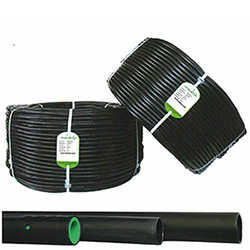
Drip Irrigation, with a general definition, is the application of the water required for plant growth by means of a certain pipe system and applied in the form of drops around the plant root zone by means of a special structure called drippers placed on or inside the side pipe (Lateral). The main purpose of drip irrigation is to give the water used by the plant, if desired, together with plant nutrients, without creating an excessive water demand.
Drip Irrigation system is to apply water to a certain part of the soil at frequent intervals and in a small amount with pipes with small cross-sectional area, operating under lower operating pressure than the sprinkler irrigation system.
The Drip Irrigation system consists of the control unit, pipelines and drippers. The control unit is the section where the pressure is regulated, the water is filtered, water measurement processes are made and fertilizers can be applied.
Benefits of Drip Irrigation Pipes
- Labyrinths placed in the pipe at regular intervals ensure that the desired amount of water is delivered to the root of the plant.
- In addition, with this method, water-soluble fertilizers are delivered to the root of the plant together with the water. Thus, it also saves fertilizer.
- In agriculture where conventional irrigation methods are applied, the plant takes more roots to reach water; However, in this system, since the water is given directly to the root of the plant, the plant does not take root much and the power goes to the product instead of the root.
- Since the drip irrigation system reduces the humidity in the air, it significantly prevents diseases such as fungus that spread in a humid environment.
- It does not allow weed growth.
- It provides aeration of the soil.
- Increases water usage efficiency. It provides high savings compared to conventional irrigation methods.
- It minimizes irrigation labor.
Pipelines and Drippers
- a) Main Pipe: PE100 Pipes are used in the diameter range of Ø32 – Ø160mm.
- b) Manifold Pipe: It is used to distribute from the main pipe to the Lateral and Drippers. They are PE100 Coil Pipes in the diameter range of Ø20 – Ø63mm.
- c) Lateral Pipes: Ø16 – Ø20mm dripper pipes laid parallel to the plant row.
Drip Irrigation Properties;
- After the harvest, collect the pipes from the field so that they do not break in the coil..
- Keep away from the sun
- When collecting from the field, the pipes are attached to the root and around the root. For this reason, do not force it too much.
- Before the Drip Irrigation Pipes are collected from the field, absolutely clean the dirt and chemicals that have gotten into them.
- It should be stacked in such a way that it will not be damaged at the place where it will be stored.
- It should be kept out of reach of rodents.
- At the end of the season, care should be taken not to wrap the pipes with reels of very small diameter in order to avoid mechanical damage while being removed from the field. Collected reels should be protected against damage by rodents such as mice in the warehouses where they are removed.

